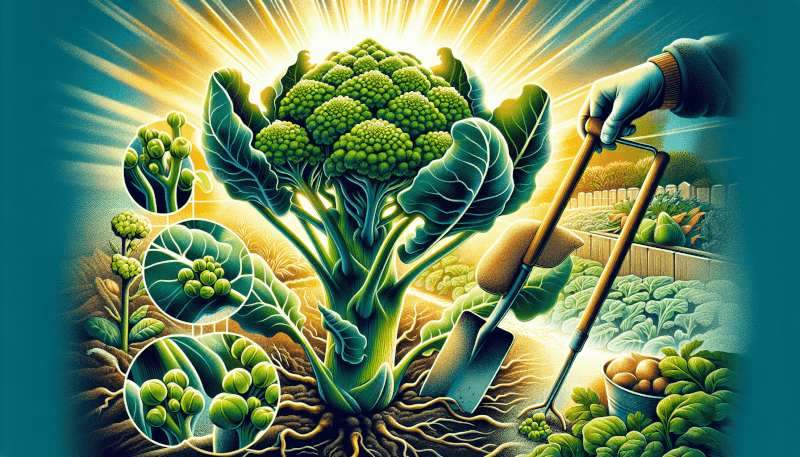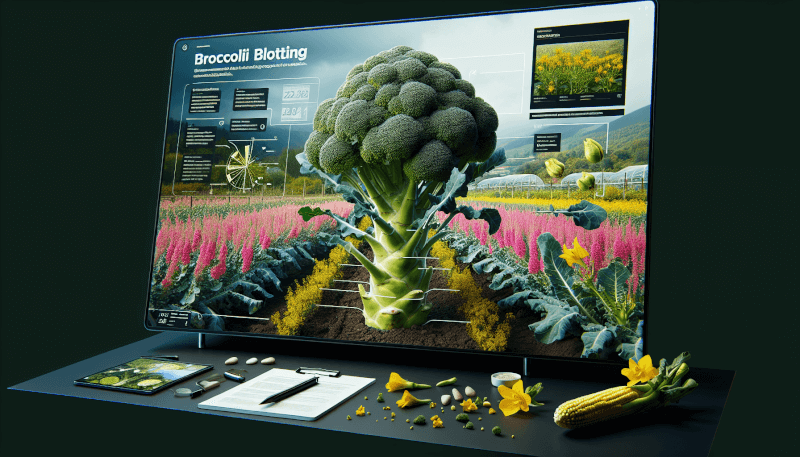Alright, so here’s the scoop – the broccoli seeds have bolted! Yes, it’s not the usual progression you’d expect from a crop, but it seems these little green powerhouses have decided to take matters into their own hands. The story behind this unexpected twist is as intriguing as it is captivating, and you’ll find yourself intrigued by the secret lives of these seemingly innocent seeds. Let’s get ready to uncover the hidden world of broccoli seeds that have gone rogue and bolted into a wild adventure of their own.

What Does It Mean When Broccoli Seeds Bolt?
Definition of Bolting
Bolting refers to the premature flowering and seed production of broccoli plants. Typically, broccoli is a cool-season crop that grows best in mild temperatures. However, under certain conditions, such as excessive heat or long daylight hours, the plants can produce flower stalks prematurely, diverting energy from the development of edible florets.
Causes of Bolting in Broccoli Seeds
Several factors can trigger bolting in broccoli seeds. The most common cause is environmental stress, particularly high temperatures. When exposed to heat above their optimum range, broccoli plants may interpret this as a signal to reproduce before the unfavorable conditions worsen. Additionally, an extended period of daylight, known as photoperiod, can induce bolting. Inadequate water supply, improper planting time, and overfertilization can also contribute to the premature flowering of broccoli plants.
Signs of Bolting in Broccoli Seeds
Recognizing the signs of bolting in broccoli seeds is crucial for timely intervention. As the plants begin to bolt, you will notice the central stem elongating rapidly and eventually producing small yellow flowers. The broccoli florets may become smaller, and the leaves may turn yellow or brown. These changes indicate that the plant is diverting energy towards seed production rather than developing tasty, consumable parts.
Effects of Bolting on Broccoli Seed Plants
Stunted Growth
Bolting can significantly impact the growth of broccoli plants. Once the plant starts flowering, the energy that would have been used to support vegetative growth is redirected to seed production. As a result, the plant’s growth may become stunted, leading to a smaller overall size compared to non-bolting plants.
Decreased Yield
One of the most noticeable effects of bolting is a decreased yield of edible broccoli florets. As the plant shifts its focus towards producing seeds, the development of large, desirable florets is compromised. Instead, the florets become smaller, less tender, and less flavorful. This can be disappointing for gardeners who were expecting a bountiful harvest of delicious broccoli.
Bitter Tasting Broccoli
Bolting also affects the flavor of broccoli. As the plant diverts resources towards seed production, the florets can become bitter. Bitterness is often associated with the presence of compounds such as glucosinolates and isothiocyanates, which accumulate when the plant becomes stressed or matures prematurely. These compounds can alter the taste of broccoli, making it less palatable.
Preventing Bolting in Broccoli Seeds
Choosing the Right Broccoli Varieties
Selecting broccoli varieties that are less prone to bolting is an essential step in preventing premature flowering. It is advisable to choose heat-tolerant or slow-bolting varieties specifically bred for your region. These varieties have been developed to withstand higher temperatures and have a lower tendency to bolt. Consulting local garden centers or experienced gardeners can provide valuable insights into the best broccoli varieties for your climate.
Proper Planting Time
Planting broccoli seeds at the right time is crucial to minimize the risk of bolting. Broccoli is a cool-season crop that prefers moderate temperatures. It is essential to start seeds or transplant seedlings during the recommended planting window for your region. By avoiding planting too early or too late, you can ensure that the plants have the ideal conditions to establish themselves before the onset of extreme weather, reducing the chances of bolting.
Temperature Control
Controlling the temperature around broccoli plants is vital in preventing bolting. Providing shade during the hottest parts of the day can help moderate temperature and prevent heat stress. This can be achieved by using shade cloth or strategically positioning taller plants to create shade. Additionally, mulching around the base of the plants can help maintain soil moisture and temperature, providing a more favorable environment for the broccoli to grow without bolting.
Moisture Management
Maintaining consistent moisture levels is crucial in preventing bolting. Adequate watering is essential, especially during hot and dry periods, to ensure that the plants remain hydrated and stress-free. However, it is equally important to avoid overwatering, as excessively moist soil can also trigger bolting. Regularly monitoring the moisture levels in the soil and adjusting watering accordingly can help create an optimal growing environment for broccoli.
Proper Fertilization
Balanced and appropriate fertilization plays a role in preventing bolting. Nitrogen-rich fertilizers can potentially stimulate vegetative growth, reducing the likelihood of bolting. However, excessive nitrogen can also increase the risk of bolting. It is important to follow recommended fertilization guidelines and avoid overfertilizing, particularly with high-nitrogen fertilizers. Consulting a local agricultural extension office or a knowledgeable horticulturist can provide guidance on suitable fertilization practices for broccoli.
Regular Harvesting
Regularly harvesting mature broccoli florets can help prevent bolting. By promptly removing the large, edible florets, you can signal to the plant that its purpose is to produce more and larger florets instead of focusing on reproduction. Regular harvesting also ensures that the plant’s energy is directed towards producing more desirable florets and discourages the development of flower stalks.
How to Deal with Bolting Broccoli Plants
Harvesting the Blooming Broccoli
When broccoli plants bolt, it doesn’t necessarily mean that the entire plant should be discarded. In fact, the flowering part of bolting broccoli can still be harvested and utilized. Before the florets start to open fully, you can harvest the blooming broccoli and incorporate it into your meals. While the texture and taste may be slightly different than non-bolting broccoli, it can still be a flavorful addition to stir-fries, sautés, or even salads.
Removing Bolting Broccoli Plants
If the bolting broccoli plants are no longer providing desirable florets or you need the space for other crops, removing the plants entirely might be the best option. Carefully uproot the plants and dispose of them, making sure not to let any mature seeds drop on the ground. Properly disposing of the plants reduces the risk of those mature seeds becoming weeds in your garden.
Composting Bolting Broccoli
Another option for dealing with bolting broccoli plants is to compost them. While the flowering part of the broccoli should not be added to the compost pile, the rest of the plant can be composted. Chopped into smaller pieces, the remaining leaves, stems, and roots will decompose and contribute valuable organic matter to your compost. However, it is important to ensure that the compost reaches a high enough temperature to kill any potential seeds or diseases.

Creative Uses for Bolting Broccoli
Broccoli Flower Arrangements
The flowering stage of bolting broccoli can be beautiful and can be used to create unique and striking flower arrangements. The yellow flowers add a vibrant pop of color and can be combined with other flowers or greenery to make eye-catching bouquets. Simply cut the flowering stems and place them in a vase filled with water to enjoy the beauty of bolting broccoli in a different way.
Edible Flowers in Salads
Bolting broccoli flowers can also be used as edible blooms. Harvest the flowers before they fully open and incorporate them into salads or as a garnish for various dishes. The bright yellow color and mild flavor of the broccoli flowers can add a visually appealing and flavorful element to your culinary creations.
Broccoli Microgreens
If your bolting broccoli plants are still in their early stages of bolting, you can salvage the situation by harvesting them as microgreens. Microgreens are young, tender plants that are harvested when they have developed their first true leaves. Harvesting the bolting broccoli at this stage allows you to enjoy the delicate flavors and nutrients of broccoli in a compact form. Add these microgreens to salads, sandwiches, or use them as a garnish to enhance the nutritional value and visual appeal of your meals.
Tips for Utilizing Bolting Broccoli Seeds
Collecting and Storing Bolting Broccoli Seeds
Even though bolting broccoli may lead to a decrease in the quantity and quality of edible florets, you can still salvage something valuable from the plants – their seeds. Allow the flowers to fully mature and dry on the plant. Once the flowers have turned brown and crispy, cut off the seed heads and collect the seeds. Store the seeds in a cool, dry place, in airtight containers such as envelopes or glass jars. Properly stored broccoli seeds can remain viable for several years, ready to be planted in future growing seasons.
Using Bolting Broccoli Seeds in Cooking
While the primary purpose of broccoli seeds is to grow new plants, they can also be used in cooking. Ground or powdered broccoli seeds can be added to various dishes as a nutritional supplement. They are known to contain compounds such as sulforaphane, which is believed to have antioxidant and anti-inflammatory properties. Sprinkle a small amount of powdered broccoli seeds into smoothies, soups, or sauces to enhance their nutritional value.
Broccoli Seed Suppliers
Online Seed Companies
If you are in need of broccoli seeds, there are numerous online seed companies that offer a wide range of broccoli varieties. These companies provide convenient access to a diverse selection of seeds, including those specifically bred for heat tolerance or slower bolting. Some reputable online seed companies include Johnny’s Selected Seeds, Baker Creek Heirloom Seeds, and Seed Savers Exchange.
Local Garden Centers
In addition to online seed companies, local garden centers or nurseries are excellent sources for broccoli seeds. These establishments often carry seeds that are suitable for local growing conditions and can provide valuable advice and recommendations based on their knowledge of the area. Visiting a garden center allows you to physically examine the seed packets and seek personalized guidance from experienced staff.
Alternative Greens to Grow Instead of Bolting Broccoli
Kale
If you are seeking a substitute for broccoli that is more resistant to bolting, kale is an excellent choice. Kale is known for its hardiness and ability to thrive in various weather conditions. It is a nutrient-dense green that can be harvested for an extended period, providing a sustainable source of leafy greens. Choose different varieties of kale, such as Curly Kale or Lacinato Kale, to add variety to your garden and meals.
Swiss Chard
Swiss chard is another alternative to consider when bolting is a concern. With its vibrant stalks and large, glossy leaves, Swiss chard is both visually appealing and nutritious. This leafy green is known for its versatility in cooking, making it an excellent addition to dishes such as stir-fries, soups, and salads. Swiss chard is usually heat-tolerant and can withstand a range of temperatures, reducing the risk of premature bolting.
Collard Greens
Collard greens are a nutritious and reliable choice if you are looking for greens that are less prone to bolting. These hearty greens have a rich flavor and are often used in traditional Southern cuisine. Collard greens are known for their ability to withstand heat and cold, allowing for a longer growing season and reducing the likelihood of bolting. They can be enjoyed sautéed, steamed, or used as a wrap for various fillings.
Cabbage
Cabbage is a cool-season crop that can be an excellent alternative to bolting-prone broccoli. It is a member of the same family as broccoli and shares many nutritional benefits. Cabbage can be grown in a variety of sizes and shapes, offering versatility in the garden. Whether used in traditional dishes like coleslaw or fermented into sauerkraut, cabbage provides a delicious and heat-resistant option for gardeners.
Future Innovations in Broccoli Seed Cultivation
Breeding Bolting Resistant Varieties
The continuous efforts of plant breeders and researchers are focused on developing broccoli varieties that are more resistant to bolting. Through traditional breeding techniques, scientists are working to identify and incorporate genes that confer bolting resistance into new cultivars. These efforts aim to provide gardeners with options that are better suited to their specific growing conditions, reducing the risk of bolting and maximizing yield potential.
Technological Advances in Bolting Detection
Advancements in technology can aid in the timely detection of bolting in broccoli plants. Drones equipped with sophisticated imaging technology can monitor large areas of crops, quickly identifying bolting plants based on their flowering structures. This can enable farmers and gardeners to take proactive measures and prevent further bolting from occurring. By utilizing technology for early bolting detection, resources can be efficiently allocated and potential losses mitigated.
Genetic Modification for Bolting Prevention
Genetic modification, or genetic engineering, is another avenue of research aimed at preventing bolting in broccoli plants. Scientists are exploring the possibility of inserting or manipulating specific genes involved in the bolting response to create plants that are less prone to premature flowering. These genetically modified varieties could provide additional options for ensuring that broccoli plants focus their energy on producing desirable florets and yield bountiful harvests.
Conclusion
Understanding the concept of bolting in broccoli seeds is essential for achieving successful broccoli cultivation. Bolting can adversely affect plant growth, decrease yield, and alter the taste of broccoli. Implementing preventive measures such as choosing the right varieties, proper planting time, temperature control, moisture management, and regular harvesting can help minimize the risk of bolting. Additionally, there are various ways to utilize bolting broccoli, including incorporating the flowering stage into flower arrangements, using the flowers as edible blooms, and harvesting the plants as microgreens. Bolting broccoli seeds can also be collected and stored for future planting or harnessed for their nutritional benefits. By exploring alternative greens and staying informed about advancements in broccoli seed cultivation, gardeners can adapt and thrive in their pursuit of growing delicious and healthy plants.
